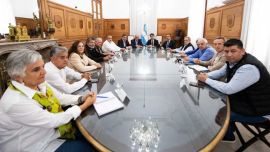The ‘Pozo de Banfield’ was one of the first first clandestine detention centres to be identified by survivors of Argentina’s 1976-1983 military dictatorship. Yet, more than 40 years on, no case investigating the crimes perpetrated there has gone to trial. Next week, that will change.
On Tuesday, a federal oral court in La Plata will begin to judge events that allegedly took place at the secret torture camp, as well as two others – known as ‘El Pozo de Quilmes’ and ‘El Infierno’ – in a unified trial.
The three-storey building that houses the Pozo de Banfield lies in the southern suburbs of Buenos Aires, less than 30 kilometres from the capital. At least 253 people were illegally held there during its time of operation.
Prosecutors believe the site was the largest clandestine detention centre in the infamous ‘Camps circuit,’ a host of secret facilities overseen by General Ramón Camps, the head of Buenos Aires provincial police, and Miguel Osvaldo Etchecolatz, the head of investigations for the Buenos Aires provincial police force.
As well as a being a site for the detention and torture of detainees snatched off the streets and from their homes, it also operated as a secret maternity ward and as a base where operations that formed part of the Condor Plan were drawn up.
Today, none of the three aforementioned sites are functioning as police stations. They have been reclaimed and turned into memorials, which detail the aberrant events that took place during the years preceding and during the last dictatorship.
In the dock
Prosecutors believe that the three sites all fell under Etchecolatz’s command, as well as being overseen by then-provincial government minister Jaime Lamont Smart. Both will be in the dock on Tuesday, along with at least 15 others. The charges levelled at the accused include crimes such homicide, the illegal deprivation of liberty, use of torture, sexual abuse, abduction and the concealment of minors.
For the first time, provincial police officer Juan Miguel Wolk – an infamous alleged human rights repressor known by the alias ‘El Nazi’ who is said to have been in charge at Pozo de Banfield and the Lanús Investigation Brigade known as "El Infierno" – will also be in the dock.
"This is a very important trial because these are the largest clandestine centres within the so-called ‘Camps Circuit’ and in the whole country. This trial covers the status of more than 500 victims," Assistant Prosecutor Juan Martín Nogueira told the Times.
Nogueira, along with Ana Oberlin, Hernán Schapiro and Gonzalo Miranda, will serve as the lead prosecutors in the trial, which is expected to last more than two years.
During the hearings, which will take place every Tuesday, Judges Walter Venditti, Ricardo Basílico and Esteban Carlos Rodríguez Eggers are scheduled to hear testimony from more than 400 witnesses, who will talk about the conditions of detention and the abduction of their loved ones.
Some, however, will not be heard. Survivors’ groups have complained about the length of time the case has taken to come to trial. At least three individuals who were set to testify – Adriana Calvo, Nilda Eloy and Cristina Gioglio – have died while waiting for proceedings to commence.
Bearing witness
The Pozo de Banfield began operating as a clandestine centre in 1974, two years before the coup that would see the military take over Argentina.
Given how early it was in operation, it was a key site for the junta. During the dictatorship, the site was the final destination for one of the groups of high-school students kidnapped on the so-called ‘Noche de los Lápices’ (“Night of the Pencils”), an infamous series of kidnappings that took place in September 1976 in La Plata.
"It is very important for us that the trial finally begins and that Wolk is finally sitting in the dock. For 25 years, Wolk pretended to be dead [in order] to evade justice," Marta Ungaro, whose brother Horacio was taken away and disappeared, told the Times.
Emilce Moler is one of few who survived the operation. She, unlike Ungaro's group, was kidnapped and taken to Pozo de Quilmes. For almost 35 years, she has repeatedly born witness to what happened there. She says she is ready to do so again.
"Once again I will have to testify. I have already done so many times [at other trials], but we are absolutely convinced that this is the only way to build a more just society," said Moler.
Secret maternity ward
Both prosecutors and plaintiffs point out that at the three clandestine centres there was a common practice of sexual violence, including forced nudity, abuse and rape. At Pozo de Banfield – the largest of the centres – there was also a secret maternity ward, where abducted women were taken to give birth to their children.
In the 1985 Trial of the Juntas, Adriana Calvo gave a devastating account of how she delivered her baby daughter Teresa in a patrol car, while being taken from a police station in La Plata to Banfield. There she had to undergo further mistreatment at the hands of police doctor Jorge Bergés (who will also be in the dock) too.
Fortunately Adriana and her baby survived. Yet Calvo, one of the most iconic figures among local human rights organisations, died in December 2010 while waiting for her moment in court.
“Pozo de Banfield was the largest clandestine maternity ward in the province of Buenos Aires," Emanuel Lovelli, the coordinator of the Plaza de Mayo Grandmothers' legal team, told theTimes.
He says the NGO will be closely watching the case, hoping that it may assist their tireless search for missing grandchildren who still haven’t been found.
"According to what we have been able to reconstruct, at least 18 pregnant women were abducted there. Six of them had their babies and we were able to find them [later on]. There are 12 other cases – which will be part of this trial – that we are still looking for, from Abuelas de Plaza de Mayo," he added.
The search for justice
Regional human rights advocates will also be watching closely. According to prosecutors, Pozo de Banfield also operated as the basis for Plan Condor, the repressive coordinated plan of extermination drawn up by the Southern Cone dictatorships in power at the time. At the site, prisoners were taken away from that clandestine centre and transferred to Uruguay, for example, before disappearing.
In Buenos Aires Province, within the orbit of the First Army Corps, more than 200 clandestine detention centres in total were in operation during the dictatorship, according to human rights groups.
The site known as Pozo de Quilmes was in operation as a police station until the beginning of 1977. After that, it was utilised solely as a clandestine sentence centre, holding kidnapped individuals who had been snatched up by the police and the military. At least 181 people are confirmed as having been held there.
The third torture camp in the trial is known as ‘El Infierno,’ a name reportedly given to the site by Camps himself. Formerly the headquarters of Regional Unit II of the Lanús Investigation Brigade, which was actually located in Avellaneda, at least 62 individuals were held there, with one death confirmed.
"It has been very difficult to get justice for the genocide" that took place, said plaintiff lawyer Guadalupe Godoy. "In the Pozo de Banfield case, family members and survivors filed the first complaint in 1984 against those we are only now going to trial against."
Proceedings next week will begin virtually, given the restrictions in place to tackle the spread of Covid-19 in Argentina, but Godoy feels the long road to justice has finally arrived.
"It's a strange context in the pandemic and with virtual hearings, but we still got to the beginning of this trial thanks to the selflessness of the human rights movement,” she told the Times.






















Comments